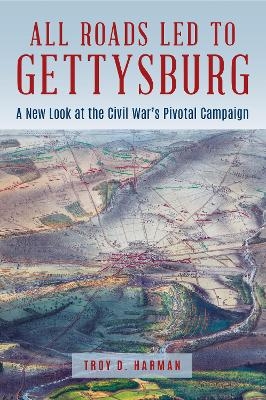
All Roads Led to Gettysburg
Stackpole Books (Verlag)
978-0-8117-7063-7 (ISBN)
Most Civil War battles took place along major roads, railroads, and waterways; the armies needed to move men and equipment, and they needed water for men, horses, and artillery. And yet this perspective hasn’t been fully explored when it comes to Gettysburg. Look at an 1863 map, says Harman: look at the area framed in the north by the Susquehanna River and in the south by the Potomac, in the east by the Northern Central Railroad and in the west by the Cumberland Valley Railroad. This is where the armies played a high-stakes game of chess in late June 1863. Their movements were guided by strategies of caution and constrained by roads, railroads, mountains and mountain passes, rivers and creeks, all of which led the armies to Gettysburg. It’s true that Lee was disadvantaged by Stuart’s roaming and Meade by his newness to command, which led both to default to the old strategic and logistical bedrocks they learned at West Point—and these instincts helped reinforce the magnetic pull toward Gettysburg.
Moreover, once the battle started, Harman argues, the blue and gray fought tactically for the two creeks—Marsh and Rock, essential for watering men and horses and sponging artillery—that mark the battlefield in the east and the west as well as for the roadways that led to Gettysburg from all points of the compass. This is a perspective often overlooked in many accounts of the battle, which focus on the high ground—the Round Tops, Cemetery Hill—as key tactical objectives.
Gettysburg Ranger and historian Troy Harman draws on a lifetime of researching the Civil War and more than thirty years of studying the terrain of Gettysburg and south-central Pennsylvania and northern Maryland to reframe the story of the Battle of Gettysburg. In the process he shows there’s still much to say about one of history’s most written-about battles. This is revisionism of the best kind.
Troy D. Harman has been a National Park Service ranger since 1984, including stints at Appomattox Court House National Historic Park, Mammoth Cave National Park, Fredericksburg & Spotsylvania National Military Park, and Independence National Historical Park. Since 1989 he has worked at Gettysburg National Military Park, where he has become one of the battlefield’s most popular and engaging rangers, with a devoted following on PCN, the Pennsylvania Cable Network. Harman, who holds a doctorate in history from Lehigh University, has published numerous articles in various Civil War publications, has spoken to Civil War Round Tables and seminars around the country, and appears regularly on the Pennsylvania Cable Network. He is an adjunct professor at Penn State University. He lives near Gettysburg.
| Erscheinungsdatum | 08.07.2021 |
|---|---|
| Verlagsort | Mechanicsburg, Pennsylvania |
| Sprache | englisch |
| Maße | 160 x 238 mm |
| Gewicht | 572 g |
| Themenwelt | Geschichte ► Allgemeine Geschichte ► Neuzeit (bis 1918) |
| Geisteswissenschaften ► Geschichte ► Regional- / Ländergeschichte | |
| Geschichte ► Teilgebiete der Geschichte ► Militärgeschichte | |
| ISBN-10 | 0-8117-7063-X / 081177063X |
| ISBN-13 | 978-0-8117-7063-7 / 9780811770637 |
| Zustand | Neuware |
| Haben Sie eine Frage zum Produkt? |
aus dem Bereich


